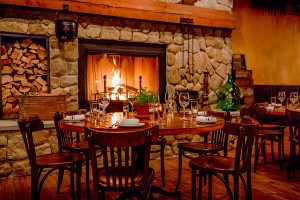The Kitchen Spy: Liz Vilardi and Nick Zappia of The Blue Room, Central Bottle, and Belly Wine Bar
In The Kitchen Spy, we visit local restaurant insiders’ home kitchens and force them to open up their fridge, drawers, and cabinets.
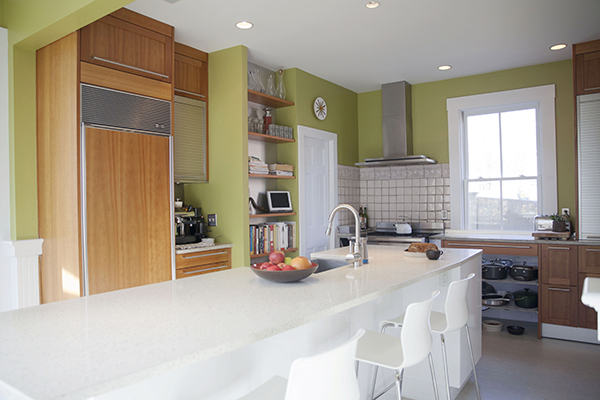 All photos by Fawn Deviney for Boston magazine
All photos by Fawn Deviney for Boston magazine
Take one glance at the kitchen in Nick Zappia and Liz Vilardi’s West Roxbury home, and you’ll likely have the same thought I did (dang, this thing is spotless!). It’s not just for show, though. “I am crazy. Our entire house looks like that,” Vilardi admits. The couple, who collectively own The Blue Room, Central Bottle, and most recently Belly Wine Bar, share their house with 4-year-old son Lucian, two cats, and a plethora of wines, cheeses, and other goodies purloined straight from Central Bottle. Learn about these—along with their go-to books, family heirlooms, and love of typography—ahead.
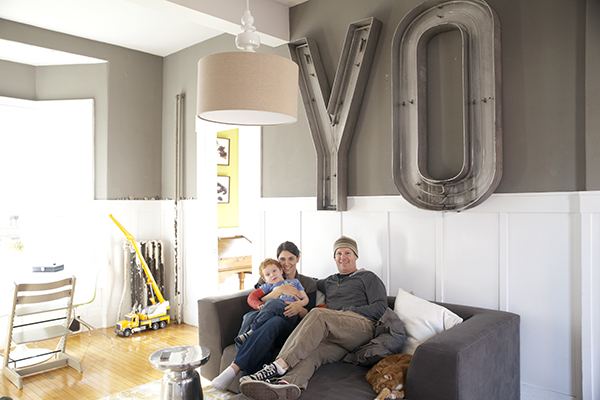
Vilardi (left) and Zappia sit in the living room with Lucian, beneath a massive YO sign that was purchased at the Brimfield market. “We were at Brimfield last spring, and we were looking for stuff for Belly—table bases and tabletops. We walked by these letters, and I’m always struck by graphic lettering,” says Zappia. “We thought they were funny, because when Nick and I just worked together, before we were ever dating, whenever he or I would walk in [the restaurant], we’d just say, ‘YO.’ We still ‘YO’ one another pretty good,” Vilardi says.
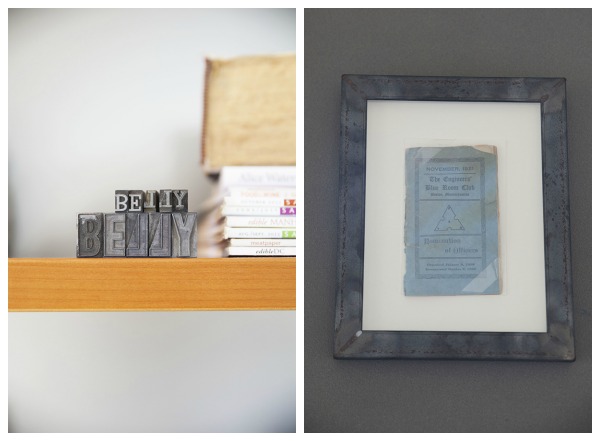 Left: Typeset letters spelling out Belly, a gift to Vilardi and Zappia from Central Bottle chef Stacy Daley
Left: Typeset letters spelling out Belly, a gift to Vilardi and Zappia from Central Bottle chef Stacy Daley
Right: A primitive Yellow Pages booklet of sorts called the “Blue Room Club,” which Zappia and Vilardi discovered in the wall of their house when they were doing renovations. “We pulled the walls open, and one of the things in the wall was this little book. We had already owned The Blue Room for eight years or so at that point,” Zappia says. “It shocked us that we found this thing printed in the early ’20s called The Blue Room Club. It was an organization of craftsman, pre-union actually, where people could advertise their services.”
 Top left: On the top shelf, a selection of wine decanters. “It seems like a collection, but we use them very often,” Zappia says. “There’s some good for a magnum, and some easy-going for a simple bottle. The angled one is good for something that has a lot of sediment. When we have people over, it’s fun to have different decanters of things at the same time.”
Top left: On the top shelf, a selection of wine decanters. “It seems like a collection, but we use them very often,” Zappia says. “There’s some good for a magnum, and some easy-going for a simple bottle. The angled one is good for something that has a lot of sediment. When we have people over, it’s fun to have different decanters of things at the same time.”
Top right: A copy of Fanny at Chez Panisse, a gift from Belly bar manager Fanny Katz’s parents, Cheryl and Jeffrey (whose firm, C&J Katz, is behind the design of Barbara Lynch restaurants Menton, Drink, Sportello, and more). “Fanny at Chez Panisse is Alice Waters’ daughter’s book about growing up at Chez Panisse,” Vilardi explains. It’s particularly relevant to Vilardi and Zappia, as their son, Lucian, spends tons of time in their restaurants.
Bottom: The cookbooks that the couple relies on the most. Highlights from left: Deceptively Delicious by Jessica Seinfeld (“It’s a totally awesome cookbook about hiding veggies in your children’s food,” Vilardi says); The Balthazar Cookbook (“We bought that because I was like, ‘I want to make coq a vin!'” Vilardi says); Flour by Joanne Chang (“Joanne is just a good friend and we love her book. Lucian has a mad crush on Joanne, and Joanne has a mad crush on Lucian,” Zappia says); Sunday Suppers at Lucques by Suzanne Goin (“[Goin] is very good friends with Pedja [Kostic], the General Manager of Iggy’s Bread, who is good friends with us. We keep it at the restaurant and here. It’s a comprehensive book of things you want to eat,” Vilardi says); Molto Mario by Mario Batali (“The motherfucker can cook and write a great recipe,” Vilardi says).
Fridge time! 1. Pizza from Whole Foods, a favorite of Lucian. 2. “That’s my fancy stuff: 2006 Kreydenweiss Gewurztraminer 2006. Sometimes we keep something special there,” says Vilardi (who is the wine director at all three of their concepts). 3. Several preserves and jams from Central Bottle are always on hand. In the fridge now, you’ll find fig jam, peach and nectarine jam, blood orange and campari jam (which Vilardi loves with heavy, creamy cheeses), and green tomato jam. “[Central Bottle chef] Stacy is particularly proud of that one because she was a farmer for 10 years, and took tomatoes from organic farmers again this year,” Vilardi says. 4. A selection of cheeses, stored in a cheese box (more on those below). 5. Verjus vinaigrette, which Vilardi uses to add a citrus-like acidity to cold-weather veggies. 6. Leftovers from a recent meal at The Blue Room. As for their go-to orders? “I’m addicted to the lamb cassoulet,” Zappia says. “My go-to always changes. We eat a lot of pork chops. We are going to turn into pigs soon,” says Vilardi. 7. Cooked Setaro pasta, which is stocked at Central Bottle. “We eat pasta more than any other meal ever,” Vilardi says. 8. From left: beers from Pretty Things (Vilardi loves Fluffy White Rabbits and Field Mouse Farewell), and three bottles of The Blue Room’s house white wine, Cincinnato Bellone Castore.
Fridge time part two! Zappia and Vilardi’s condiment essentials include ground mustard, flax oil (for Lucian’s smoothies), Newman’s Own ranch dressing (also for Lucian), and more verjus (a tart vinegar-like substance made from pressed grapes).
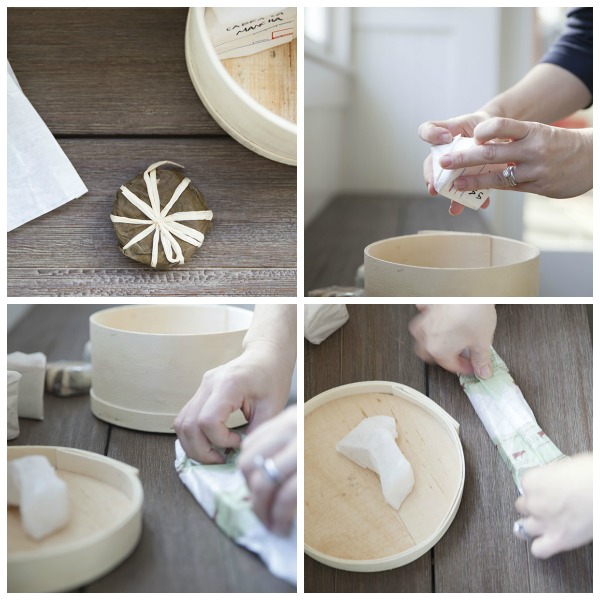 Back to that cheese box. “The cheese box saved our lives,” Vilardi says. “It keeps a great little environment for the cheeses. It keeps them slightly warmer than the rest of the fridge,” Zappia says. “We let it sit out on the counter and we nibble when we are making dinner.” Also essential: Cheese paper. “It’s essential for storing cheeses,” Vilardi says. Some favorites currently taking up residence in the box? The Rapture, from Lazy Lady Farms in Vermont, and Roves des Garrigues, a fresh, herbacious goat cheese from the south of France.
Back to that cheese box. “The cheese box saved our lives,” Vilardi says. “It keeps a great little environment for the cheeses. It keeps them slightly warmer than the rest of the fridge,” Zappia says. “We let it sit out on the counter and we nibble when we are making dinner.” Also essential: Cheese paper. “It’s essential for storing cheeses,” Vilardi says. Some favorites currently taking up residence in the box? The Rapture, from Lazy Lady Farms in Vermont, and Roves des Garrigues, a fresh, herbacious goat cheese from the south of France.
 The stove is a 20-year-old restaurant-quality Wulf range that Zappia purchased when he was working at The Blue Room and East Coast Grill (before he was an owner at TBR). “It actually was the first thing that came into the kitchen and then we built around it,” he says. “It throws out a ton of heat, it’s not insulated, but it has amazing firepower.” Bottom left: The couple relies on Central Bottle olive oil and Marsala wine from Intorcia (used in lieu of sherry for sauteeing mushrooms) for cooking.
The stove is a 20-year-old restaurant-quality Wulf range that Zappia purchased when he was working at The Blue Room and East Coast Grill (before he was an owner at TBR). “It actually was the first thing that came into the kitchen and then we built around it,” he says. “It throws out a ton of heat, it’s not insulated, but it has amazing firepower.” Bottom left: The couple relies on Central Bottle olive oil and Marsala wine from Intorcia (used in lieu of sherry for sauteeing mushrooms) for cooking.
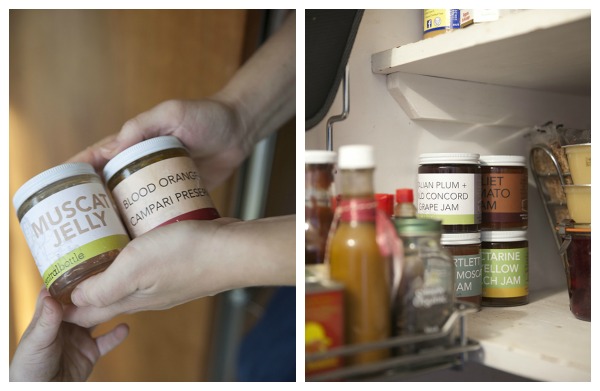 A variety of jellies and preserves poached from Central Bottle.
A variety of jellies and preserves poached from Central Bottle.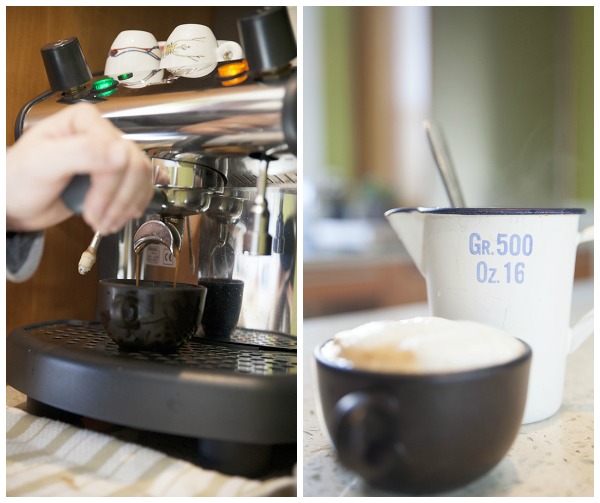
“That’s Nick’s baby,” Vilardi says of the Bezzera machine that the couple relies on for their daily espresso and cappuccinos. “It’s our most souped-up and most successful [machine], in that it’s the best quality espresso that we’ve had. This was in the under-$2,000 range. It makes great restaurant-quality espresso,” Zappia says.
Left: The family is “big toast eaters,” per Vilardi. Right: Hand-blown glassware from RISD-based artist Laura Kramer of LBK Studios. “Nick and I are big Italiano-files. Anything Venetian, glass-blown, I’m on board,” Vilardi says. “We have them in green, black, white, and red. They weigh like nothing.”
 The utility drawer. At left, cooking tongs, which “double as weapons for our son. They are all over the house,” Vilardi says. In the center, wooden spoons that were once Vilardi’s grandmother’s (more on that below). Bottom right, weathered butter knives that they rely on for cheese.
The utility drawer. At left, cooking tongs, which “double as weapons for our son. They are all over the house,” Vilardi says. In the center, wooden spoons that were once Vilardi’s grandmother’s (more on that below). Bottom right, weathered butter knives that they rely on for cheese.
 Top left and top right: “Half of the [wooden spoons] are from Liz’s mom’s collection. Liz’s mom passed away almost two years ago, and we ended up with her older kitchen wares,” Zappia says. “The mallet thing is more [decorative],” Vilardi says. “I haven’t figured out what to do with it.”
Top left and top right: “Half of the [wooden spoons] are from Liz’s mom’s collection. Liz’s mom passed away almost two years ago, and we ended up with her older kitchen wares,” Zappia says. “The mallet thing is more [decorative],” Vilardi says. “I haven’t figured out what to do with it.”
Bottom right: Cast-iron skillets that belonged to Vilardi’s grandmother. “She was an awesome cook. I cooked with my grandma, [Carolyn], a lot,” she says. “The little guy was for eggs, and the big guy was for red-eye gravy. She fried god-knows-what in the big one.” Nowaways, they use the small skillet for omelets for Lucian, and the big skillet for pork chops.
Bottom left: Vilardi’s mother’s recipe book, opened to acini [de pepe, a type of pasta] soup. “My mom was a good cook, and she had filled [the book] with Thanksgiving recipes and things we loved to eat. Almost all of her recipes start with ‘a large bone,'” she says. “[The soup] was a giant hunk of braised meat with tomatoes, and you fill a bowl with acini, add the braised meat and add shaved Parmesan and olive oil.”
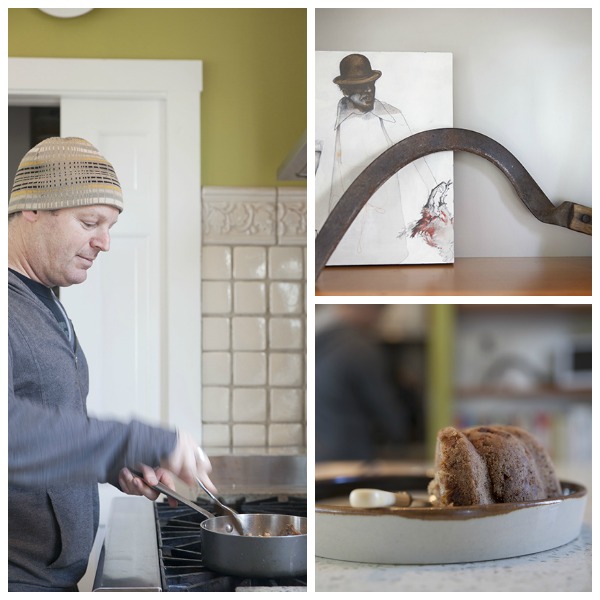 Left: Zappia reheats The Blue Room leftovers. Top right: A sickle that once belonged to Zappia’s grandfather. “[Growing up], we lived in Yonkers, New York, and my grandfather was from Calabria, and he was a baker in the Italian army in World War I,” Zappia says. “He was also a prolific gardener. In our house that I grew up in, we had a huge garden in the back of the house that he would always tend to. You would see my grandfather walking down the street with a brown paper bag for lunch and the sickle in the other hand, and he’d come to our garden and work on it during the day.” The painting behind it used to hang in The Blue Room. Bottom right: Apple spice cake that Zappia’s mother made when she was in town visiting. “Every time I come near her house or she comes over, she’s always baking my favorite things,” he says.
Left: Zappia reheats The Blue Room leftovers. Top right: A sickle that once belonged to Zappia’s grandfather. “[Growing up], we lived in Yonkers, New York, and my grandfather was from Calabria, and he was a baker in the Italian army in World War I,” Zappia says. “He was also a prolific gardener. In our house that I grew up in, we had a huge garden in the back of the house that he would always tend to. You would see my grandfather walking down the street with a brown paper bag for lunch and the sickle in the other hand, and he’d come to our garden and work on it during the day.” The painting behind it used to hang in The Blue Room. Bottom right: Apple spice cake that Zappia’s mother made when she was in town visiting. “Every time I come near her house or she comes over, she’s always baking my favorite things,” he says.
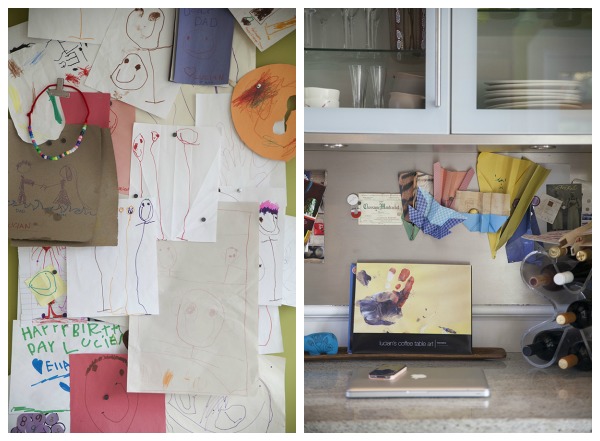 Left: Since Zappia and Vilardi’s fridge isn’t magnetic, they had to find an alternate solution (in the form of a magnetic wall-hanging from The Container Store) for displaying their son’s artwork. “This is [Lucian’s] ‘happy face long person’ phase,” Vilardi explains. Right: A book of Lucian’s past art, which Vilardi made into a book via Apple.
Left: Since Zappia and Vilardi’s fridge isn’t magnetic, they had to find an alternate solution (in the form of a magnetic wall-hanging from The Container Store) for displaying their son’s artwork. “This is [Lucian’s] ‘happy face long person’ phase,” Vilardi explains. Right: A book of Lucian’s past art, which Vilardi made into a book via Apple.
 Perhaps unsurprisingly, at a mere four years old, Lucian has already become quite knowledgeable about the world of food and wine (above, he’s playing with a wine tool kit). “He’s a restaurant kid, and for better or for worse he’s been in the restaurant since the day he was born,” Zappia says. “He knows what the glasses are for. He knows some of the things in there are for pouring wine, some are for opening wine, some are for putting in the top of the bottle. He asks a million questions and he doesn’t forget. He likes to come behind the bar, and pretend he’s making a drink. In the morning, he takes stuff out of the cabinet and says, ‘Today, my restaurant is called _____.”
Perhaps unsurprisingly, at a mere four years old, Lucian has already become quite knowledgeable about the world of food and wine (above, he’s playing with a wine tool kit). “He’s a restaurant kid, and for better or for worse he’s been in the restaurant since the day he was born,” Zappia says. “He knows what the glasses are for. He knows some of the things in there are for pouring wine, some are for opening wine, some are for putting in the top of the bottle. He asks a million questions and he doesn’t forget. He likes to come behind the bar, and pretend he’s making a drink. In the morning, he takes stuff out of the cabinet and says, ‘Today, my restaurant is called _____.”
Find past editions of The Kitchen Spy here.
For more online food coverage, find us on Twitter at @ChowderBoston.



